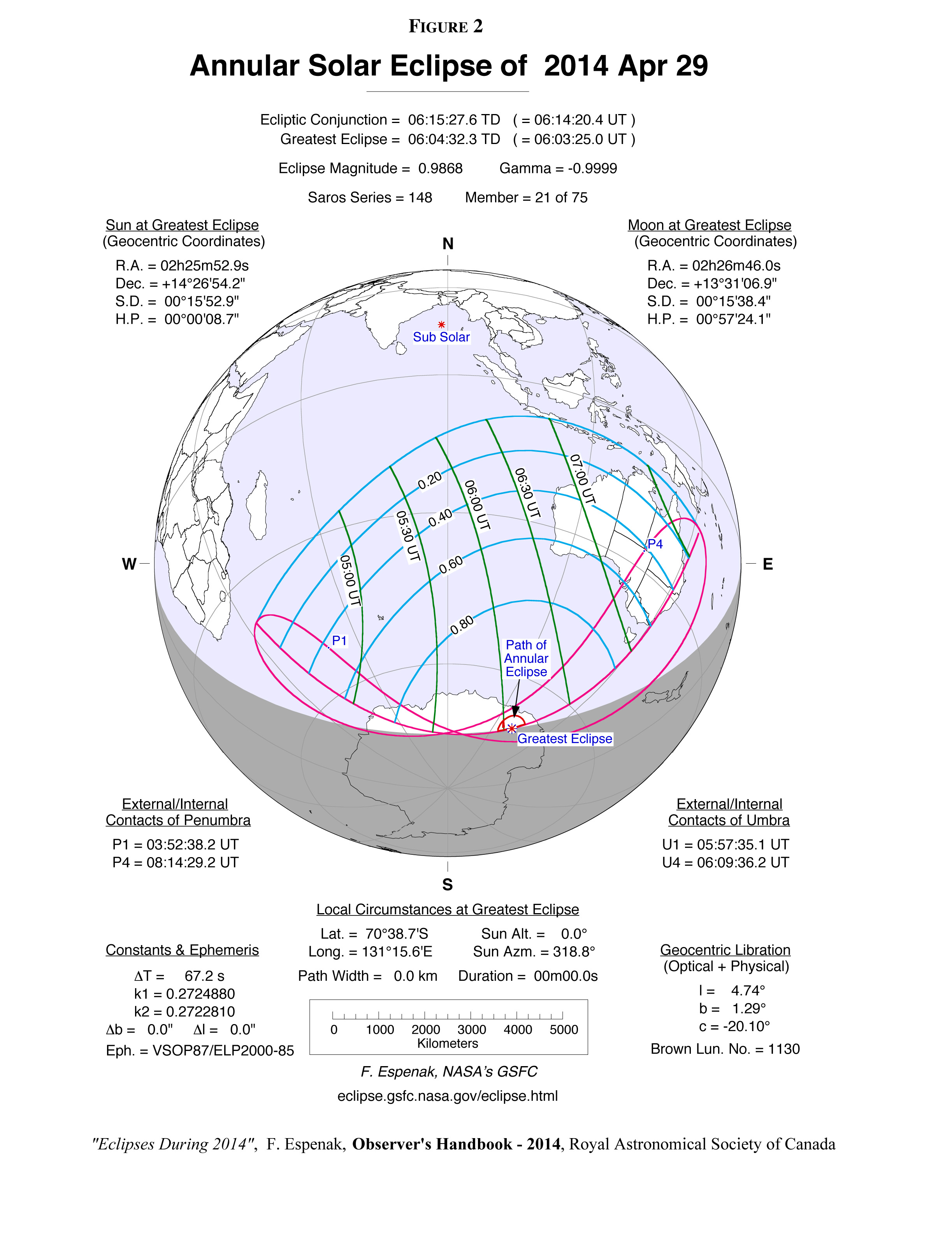Solar Eclipses of 2014: Complete Coverage
The year 2014 was marked by two solar eclipses, with stargazers in the eclipse paths watching the moon block the sun's light on April 29 and Oct. 23, weather permitting. The first solar eclipse of 2014 was an annular solar eclipse (or "ring of fire" eclipse), while the October event was a partial solar eclipse.
Latest Update (April Oct. 24):
Solar eclipses occur when the moon appears to block part or all of the sun's disk as seen from Earth. When the moon blocks the entire sun, it is called a total solar eclipse. Partial eclipses occur when only a piece of the sun is obscured by the moon. When the moon passes in front of the sun, but its shadow falls short of the Earth's surface, an annular solar eclipse occurs, creating a dazzling "ring of fire" effect in the sky. WARNING: All eclipse viewing is dependent on local weather conditions and proper safety precautions must be taken to safely observe the sun. Scroll down to see our complete coverage.
Photos and Video:
Solar Eclipse Photos by Australian Stargazers: April 29, 2014
Partial Solar Eclipse Snapped Over Australia | Time-Lapse Video
Breaking space news, the latest updates on rocket launches, skywatching events and more!
Complete Coverage:
Tuesday, April 29:
First Solar Eclipse of 2014 Thrills Skywatchers in Australia: Photos
A sunset solar eclipse wowed observers in Australia Tuesday (April 29) during the first solar eclipse of 2014. See photos of the solar eclipse here. Solar Eclipse Photo Gallery / Time-Lapse Video!
Monday, April 28:
First Solar Eclipse of 2014 Will Darken Sun Tuesday: Watch Live Online
The moon will block the sun in the first solar eclipse of the year on Tuesday (April 29), and stargazers in Australia have some of the best seats on the planet. But you don't have to be in the land Down Under to see the sun spectacle — you can watch it online for free.
'Ring of Fire' Annular Solar Eclipse of April 29, 2014: Visibility Maps
European Spacecraft to Watch Solar Eclipse from Space Tuesday
Sunday, April 27:
First Solar Eclipse of 2014 Occurs Tuesday: Australia Set for Best View
The moon will blot out the sun Tuesday afternoon (April 29) in an eclipse visible across Australia, though penguins a bit farther south will have the best views of the dramatic event.
Saturday, April 26:
Interactive Solar Eclipse Guide Shows Visibility Maps for Tuesday Sun Show
A new map created by amateur astronomer Xavier Jubier lets any interested stargazer see what next week's solar eclipse will look like from his or her neck of the woods.
Wednesday, April 23:
Solar Eclipse Will Transform Sun into 'Ring of Fire' Next Week
The sun will look like a ring of fire above some remote parts of the world next Tuesday (April 29) during a solar eclipse, but most people around the world won't get a chance to see it.
Solar Eclipses: An Observer's Guide: Infographic
Related:
Total Solar Eclipses: How Often Do They Occur (and Why)?
When the Sun Blinked: 1994's Solar Eclipse: Op-Ed
The April 29 solar eclipse will begin at 1:15 p.m. local time in Perth, the capital of Western Australia, and end at 3:59 p.m. local time. Maximum coverage there occurs at 2:41 p.m., when the moon will obscure about 65 percent of the solar disk. The event will begin later in the day for observers in Melbourne (3:58 p.m. local time) and Sydney (4:13 p.m.). In both cities, with the sun setting before the solar eclipse ends.
In Antarctica, the eclipse will begin at 1:57:35 a.m. EDT (0557:35 GMT), with the time of greatest eclipse occurring six minutes later (at 2:03:25 a.m. EDT/0603:25 GMT). For any penguins at the area of greatest eclipse, the annularity — or "ring of fire" effect —will last about 49 seconds, according to NASA eclipse expert Fred Espenak.
According to Espenak Tuesday's eclipse is unique in that the "central axis of the Moon's antumbral shadow misses Earth entirely while the shadow edge grazes the planet. Classified as a non-central annular eclipse, such events are rare. Out of the 3,956 annular eclipses occurring during the 5,000-year period -2000 to +3000, only 68 of them or 1.7% are non-central (Espenak and Meeus, 2006)."
The partial solar eclipse of Oct. 23 promises to be a potentially eye-catching event because it will be widely visible from the United States and Canada. The eclipse will begin as the moon's shadow makes Earthfall in eastern Siberia, near the Kamchatka Peninsula, at 3:37:33 EDT (19:37:33 GMT).
"As the shadow travels east, much of North America will be treated to a partial eclipse. The eclipse magnitude from cities like Vancouver (0.658), San Francisco (0.504), Denver (0.556), and Toronto (0.443) will surely attract the media's attention," according to Espenak.
The time of greatest eclipse will be at 5:44:31 p.m. EDT (21:44:31 GMT) over the Nunavut Territory in Canada, near Prince of Wales Island.
"A sunset eclipse will be visible from the eastern half of the USA and Canada (except for the far northeast). The partial eclipse ends when the penumbra leaves Earth at 23:51:40 UT," Espenak wrote.
Lunar Eclipses of 2014
In addition to the two solar eclipses of 2014, there are two lunar eclipses occurring in the same year. Both moon events are total lunar eclipses, with the first occurring on April 15 and the second occurring on Oct. 8.
The total lunar eclipse of April 15 wowed millions of stargazers across North America, South America, Hawaii and parts of Alaska, due to it being widely visible across those regions. It lasted nearly 3.5 hours, beginning at about 2 a.m. EDT (0600 GMT).
Blood Moon Photos: Total Lunar Eclipse Pictures from April 15, 2014
Related: Total Lunar Eclipse of April 15: Complete Coverage of the Blood Moon
The Oct. 8 total lunar eclipse, however, will be best visible from the Pacific Ocean and coasal regions on both sides of the ocean. The time of total eclipse will last about 59 minutes during this eclipse, which will begin at 4:15:33 a.m. EDT (0815:33 GMT) and end at 9:33:43 a.m. EDT (1333:43 GMT), according to Espenak.
The two total eclipses of the moon in 2014 make up half of a four-eclipse series known as a lunar tetrad. Two more total lunar eclipses will follow, on April 4, 2015 and Sept. 28, 2015 to complete the lunar eclipse tetrad.
Follow us @Spacedotcom, Facebook and Google+.
Join our Space Forums to keep talking space on the latest missions, night sky and more! And if you have a news tip, correction or comment, let us know at: community@space.com.

Tariq is the award-winning Editor-in-Chief of Space.com and joined the team in 2001. He covers human spaceflight, as well as skywatching and entertainment. He became Space.com's Editor-in-Chief in 2019. Before joining Space.com, Tariq was a staff reporter for The Los Angeles Times covering education and city beats in La Habra, Fullerton and Huntington Beach. He's a recipient of the 2022 Harry Kolcum Award for excellence in space reporting and the 2025 Space Pioneer Award from the National Space Society. He is an Eagle Scout and Space Camp alum with journalism degrees from the USC and NYU. You can find Tariq at Space.com and as the co-host to the This Week In Space podcast on the TWiT network. To see his latest project, you can follow Tariq on Twitter @tariqjmalik.




